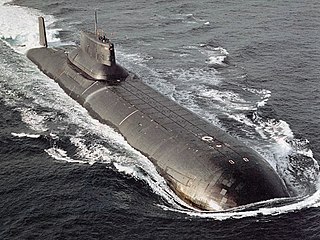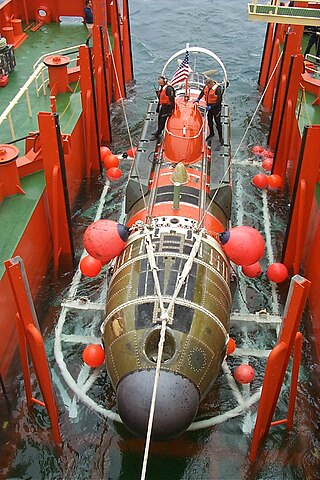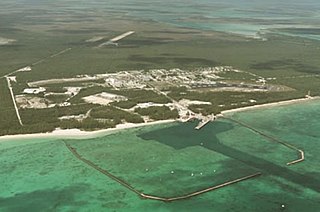
The Los Angeles class of submarines are nuclear-powered fast attack submarines (SSN) in service with the United States Navy. Also known as the 688 class after the hull number of lead vessel USS Los Angeles (SSN-688), 62 were built from 1972 to 1996, the latter 23 to an improved 688i standard. As of 2024, 24 of the Los Angeles class remain in commission—more than any other class in the world—and they account for almost half of the U.S. Navy's 50 fast attack submarines.

The Hunt for Red October is the debut novel by American author Tom Clancy, first published on October 1, 1984, by the Naval Institute Press. It depicts Soviet submarine captain Marko Ramius as he seemingly goes rogue with his country's cutting-edge ballistic missile submarine Red October, and marks the first appearance of Clancy's most popular fictional character, Jack Ryan, an analyst working for the Central Intelligence Agency, as he must prove his theory that Ramius is intending to defect to the United States.

The Cardinal of the Kremlin is an espionage thriller novel, written by Tom Clancy and released on May 20, 1988. A direct sequel to The Hunt for Red October (1984), it features CIA analyst Jack Ryan as he extracts CARDINAL, the agency's highest placed agent in the Soviet government who is being pursued by the KGB, as well as the Soviet intelligence agency's director. The novel also features the Strategic Defense Initiative (SDI), a real-life missile-defense system developed by the United States during that time, and its Russian counterpart. The book debuted at number one on the New York Times bestseller list.

John Patrick Ryan Sr. (Hon.), nicknamed Jack, is a fictional character created by author Tom Clancy and featured in his Ryanverse novels, which have consistently topped the New York Times bestseller list over 30 years. Since Clancy's death in 2013, five other authors, Mark Greaney, Grant Blackwood, Mike Maden, Marc Cameron and Don Bentley, have continued writing new novels for the franchise and its other connecting series with the approval of the Clancy family estate.

USS Pogy (SSN-647), a Sturgeon-class submarine, was the second ship of the United States Navy to be named for the pogy, or menhaden.

The submarine film is a subgenre of war film in which most of the plot revolves around a submarine below the ocean's surface. Films of this subgenre typically focus on a small but determined crew of submariners battling against enemy submarines or submarine-hunter ships, or against other problems ranging from disputes amongst the crew, threats of mutiny, life-threatening mechanical breakdowns, or the daily difficulties of living on a submarine.

The Project 941 Akula, was a class of nuclear-powered ballistic missile submarines designed and built by the Soviet Union for the Soviet Navy. With a submerged displacement of 48,000 t, the Typhoons were the largest submarines ever built, able to accommodate comfortable living facilities for the crew of 160 when submerged for several months. The source of the NATO reporting name remains unclear, although it is often claimed to be related to the use of the word "typhoon" ("тайфун") by General Secretary Leonid Brezhnev of the Communist Party in a 1974 speech while describing a new type of nuclear ballistic missile submarine, as a reaction to the United States Navy's new Ohio-class submarine.

USS Salt Lake City (SSN-716), a Los Angeles-class submarine, was the second ship of the United States Navy to be named for Salt Lake City, Utah. The contract to build her was awarded to Newport News Shipbuilding and Dry Dock Company in Newport News, Virginia on 15 September 1977 and her keel was laid down on 26 August 1980. She was launched on 16 October 1982 sponsored by Mrs. Kathleen Garn, and commissioned on 12 May 1984.

USS Puffer (SSN-652), a Sturgeon-class nuclear attack submarine, was the second ship of the United States Navy to be named for the pufferfish, a saltwater fish with toxic spines that can inflate its body with water or air and is one of the most poisonous vertebrates in the world.

Crimson Tide is a 1995 American submarine action thriller film directed by Tony Scott and produced by Don Simpson and Jerry Bruckheimer. It takes place during a period of political turmoil in Russia, in which ultranationalists threaten to launch nuclear missiles at the United States and Japan.

The Hunt for Red October is a video game based on the 1990 film The Hunt for Red October. It was first released in 1991 for the Nintendo Entertainment System. Versions for the Game Boy and Super NES were subsequently released.

DSRV-2Avalon was a Mystic-class deep-submergence rescue vehicle rated to dive up to 5,000 feet (1,500 m) to rescue submarine crews trapped deep under the sea. The submarine was acquired in response to the loss of the USS Thresher, so that the Navy would have a way to rescue trapped submarine crews.

Storozhevoy was a Soviet Navy Project 1135 Burevestnik-class anti-submarine frigate. After commissioning, the Soviet Navy assigned the ship to its Baltic Fleet and based it in Baltiysk. Storozhevoy was involved in a mutiny led by Valery Sablin in November 1975, after which it was assigned to the Pacific Fleet for the remainder of its career. It was decommissioned in June 2002.
``Ramius can refer to the following fictional characters:

Flight of the Intruder is a 1991 war film directed by John Milius, and starring Danny Glover, Willem Dafoe, and Brad Johnson. It is based on the novel of the same name by former Grumman A-6 Intruder pilot Stephen Coonts. The film received negative reviews upon release, and was Milius's final theatrical release as a director.

Morris "Mace" Alvin Neufeld was an American film and television producer. Born in New York City, Neufeld began working in the entertainment industry as a songwriter and production assistant in the late 1940s and then as a talent agent, managing comics, actors, musicians and writers, including Don Adams, Don Knotts, Neil Diamond, and the Carpenters. He began producing for television in the 1970s and in 1981 was nominated for a primetime Emmy for the TV movie East of Eden.

The United States Navy's Atlantic Undersea Test and Evaluation Center (AUTEC) is a laboratory that performs integrated three-dimensional hydrospace/aerospace trajectory measurements covering the entire spectrum of undersea simulated warfare – calibration, classifications, detection, and destruction. Its mission is to assist in establishing and maintaining naval ability of the United States through testing, evaluation, and underwater research.

The Jack Ryan franchise consists of American action-thriller installments, based on the fictional titular character from a series of novels written by Tom Clancy. Various actors have portrayed the role.
The following is a complete list of books published by Tom Clancy, an American author of contemporary spy fiction and military fiction.
















